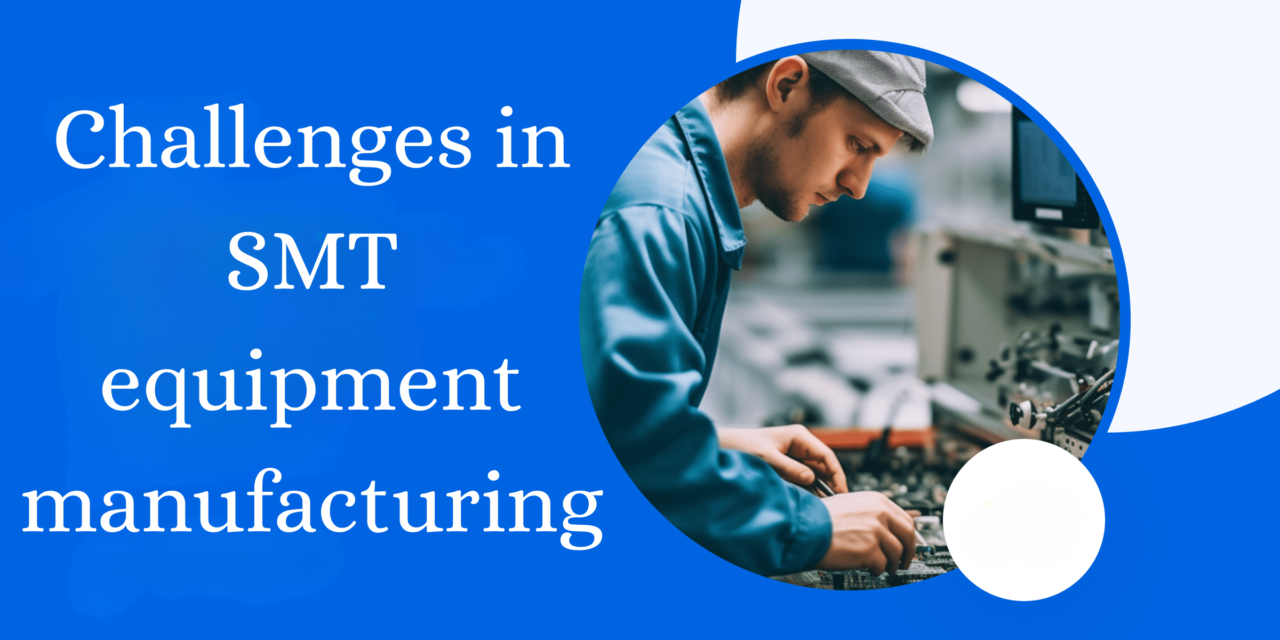Surface Mount Technology (SMT) equipment manufacturing involves complex processes that require precision, automation, and high-speed operation. As electronics continue to shrink in size while increasing in complexity, manufacturers face challenges in maintaining efficiency, accuracy, and reliability. Below are the key challenges in SMT equipment manufacturing and the strategies used to overcome them.
1. High Precision and Miniaturization of Components
Challenge:
- The increasing demand for miniaturized electronic devices requires SMT machines to place extremely small components (such as 01005 and micro BGAs) with high accuracy.
- Traditional pick-and-place systems may struggle with fine-pitch components and ultra-small packages.
Solution:
- Advanced vision systems and AI-driven component recognition improve placement accuracy.
- Laser-guided and 3D alignment systems ensure precise positioning.
- High-speed pick-and-place heads with fine nozzles enable handling of smaller components without damage.
2. High-Speed Production Without Sacrificing Accuracy
Challenge:
- The need for mass production of complex PCBs requires SMT machines to operate at very high speeds without misplacing or damaging components.
- Balancing speed and accuracy is difficult, as increasing speed can lead to component misalignment or defects.
Solution:
- Multi-head pick-and-place machines with independent vision calibration improve speed and precision.
- Real-time AI-driven optimization dynamically adjusts component placement based on production data.
- Vibration-damping technology minimizes machine errors at high speeds.
3. Soldering Defects and Thermal Management in Reflow Ovens
Challenge:
- Variations in thermal profiles can cause cold solder joints, bridging, or tombstoning in components.
- Lead-free soldering (RoHS compliance) requires higher temperatures, which can damage sensitive components.
Solution:
- AI-based thermal profiling optimizes reflow oven temperature zones for different PCB designs.
- Nitrogen reflow soldering reduces oxidation and improves solder joint quality.
- Advanced cooling systems ensure a uniform solidification process to prevent defects.
4. Quality Control and Defect Detection
Challenge:
- With increasing PCB complexity, defects such as solder bridges, misaligned components, and incomplete soldering are harder to detect manually.
- Traditional inspection methods may miss hidden defects in BGA and QFN components.
Solution:
- Automated Optical Inspection (AOI) systems with 3D imaging detect placement and soldering errors in real time.
- X-ray Inspection (AXI) systems enable non-destructive testing of hidden solder joints.
- AI-powered defect classification improves accuracy and reduces false alarms, minimizing unnecessary rework.
5. Material Handling and Feeder System Challenges
Challenge:
- SMT production requires thousands of components, and improper feeder handling can lead to misfeeds, delays, or production stoppages.
- Component reels must be loaded correctly, and misalignment can cause placement errors.
Solution:
- Intelligent feeder systems with auto-calibration reduce misfeeds and improve efficiency.
- Barcode and RFID tracking ensure proper component loading and real-time inventory management.
- Automated material handling robots transport component reels and PCBs, reducing human error.
6. Downtime and Maintenance Costs
Challenge:
- Unexpected equipment failures cause production delays and increase costs.
- Manual maintenance schedules may fail to predict potential issues, leading to sudden breakdowns.
Solution:
- Predictive maintenance using IoT sensors monitors SMT equipment performance in real time.
- AI-driven failure prediction systems alert operators before a machine breakdown occurs.
- Remote diagnostics and automated troubleshooting reduce downtime by allowing quick interventions.
7. Integration with Industry 4.0 and Smart Factories
Challenge:
- SMT lines need to integrate with Manufacturing Execution Systems (MES) for real-time data collection and process optimization.
- Older SMT machines lack connectivity, making data tracking difficult.
Solution:
- Smart SMT machines with IoT and cloud connectivity enable remote monitoring.
- AI-driven production analytics optimize efficiency by adjusting machine parameters dynamically.
- Automated data logging ensures full traceability of component placement and soldering.
8. Handling Mixed Technology (SMT and Through-Hole Components)
Challenge:
- Some PCB designs require both SMT and Through-Hole Technology (THT) components, making automation more complex.
- Manual soldering of through-hole components slows production and increases labor costs.
Solution:
- Selective soldering machines automate THT component soldering, reducing manual labor.
- Hybrid SMT-THT assembly lines with wave soldering and reflow soldering integration streamline production.
- Automated PCB flipping systems optimize double-sided assembly.
9. Environmental Regulations and Lead-Free Soldering Compliance
Challenge:
- Stricter regulations like RoHS and REACH require lead-free and eco-friendly manufacturing processes.
- Lead-free soldering increases reflow oven temperatures, leading to higher energy consumption and potential thermal stress on components.
Solution:
- Energy-efficient reflow ovens reduce power consumption while maintaining stable soldering temperatures.
- Low-melting-point solder alloys minimize heat damage to sensitive components.
- Eco-friendly flux and cleaning solutions ensure compliance with environmental standards.
10. High Initial Investment and Return on Investment (ROI) Concerns
Challenge:
- SMT equipment, such as pick-and-place machines, reflow ovens, and AOI systems, requires significant capital investment.
- Companies worry about the ROI when investing in automation.
Solution:
- Leasing and financing options make high-end SMT equipment more accessible.
- Scalable SMT solutions allow companies to upgrade machines as production grows.
- AI-driven process optimization ensures maximum utilization of equipment, improving ROI.
Conclusion
The SMT equipment manufacturing industry faces challenges in miniaturization, high-speed accuracy, defect detection, and automation integration. However, AI-driven process optimization, predictive maintenance, Industry 4.0 integration, and advanced inspection technologies have significantly improved production efficiency and quality.
By addressing these challenges, manufacturers can enhance productivity, reduce waste, and improve overall PCB assembly reliability, keeping pace with the evolving demands of the electronics industry.
Hashtags
#SMTChallenges #ManufacturingIssues #SurfaceMountTechnology #ElectronicsManufacturing #PCBAssembly #MicroComponentPlacement #HighDensityPCBs #PrecisionManufacturing #Miniaturization #ComponentShrinkage #SolderingIssues #DefectPrevention #ReflowSoldering #PCBDefects #AutomatedInspection #PickAndPlaceErrors #ComponentAlignment #SMTAccuracy #MachineCalibration #PrecisionPlacement #ThermalManagement #HeatDissipation #CoolingSolutions #ComponentShortage #SupplyChainIssues #AIinManufacturing #PredictiveMaintenance #SmartManufacturing














